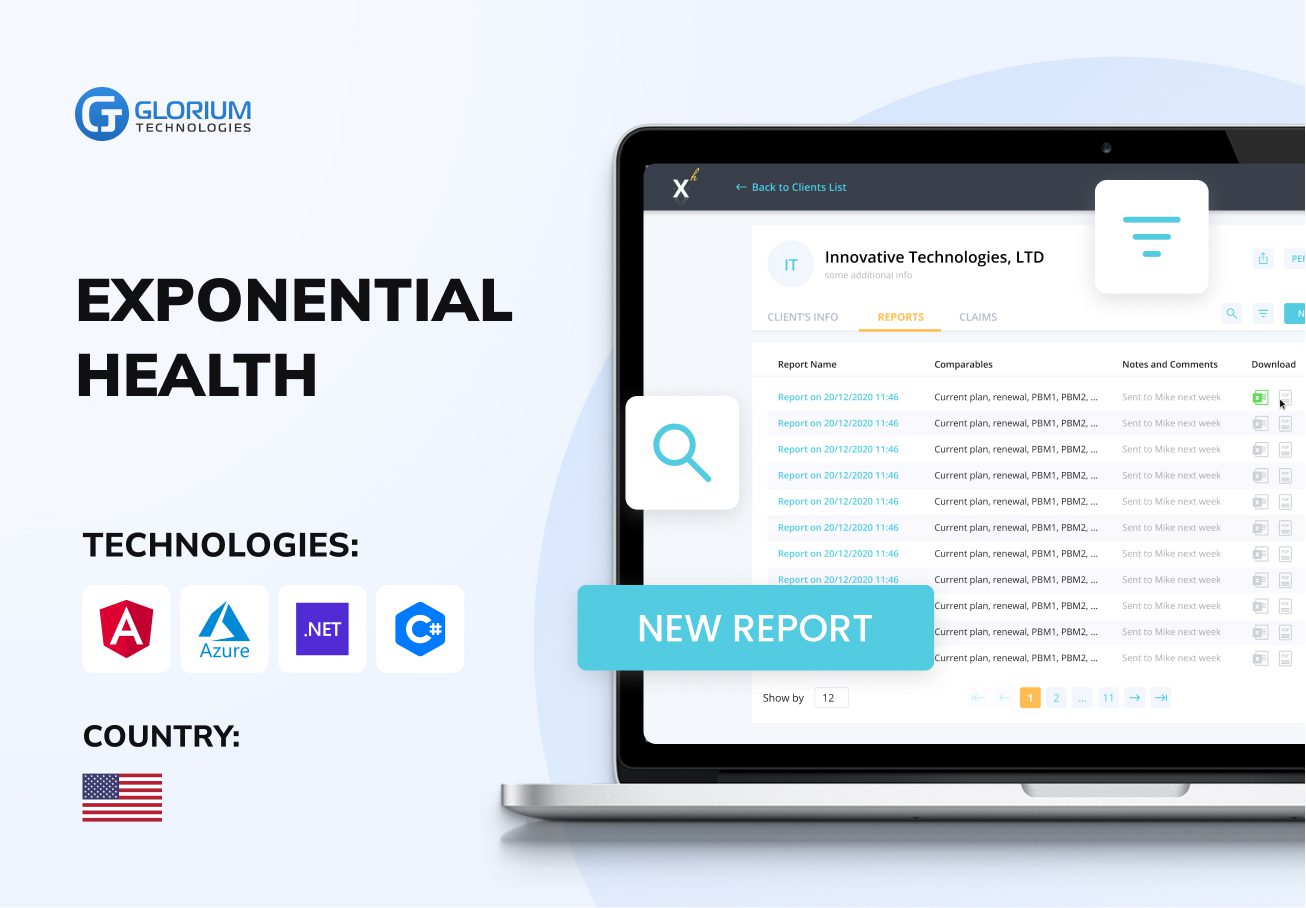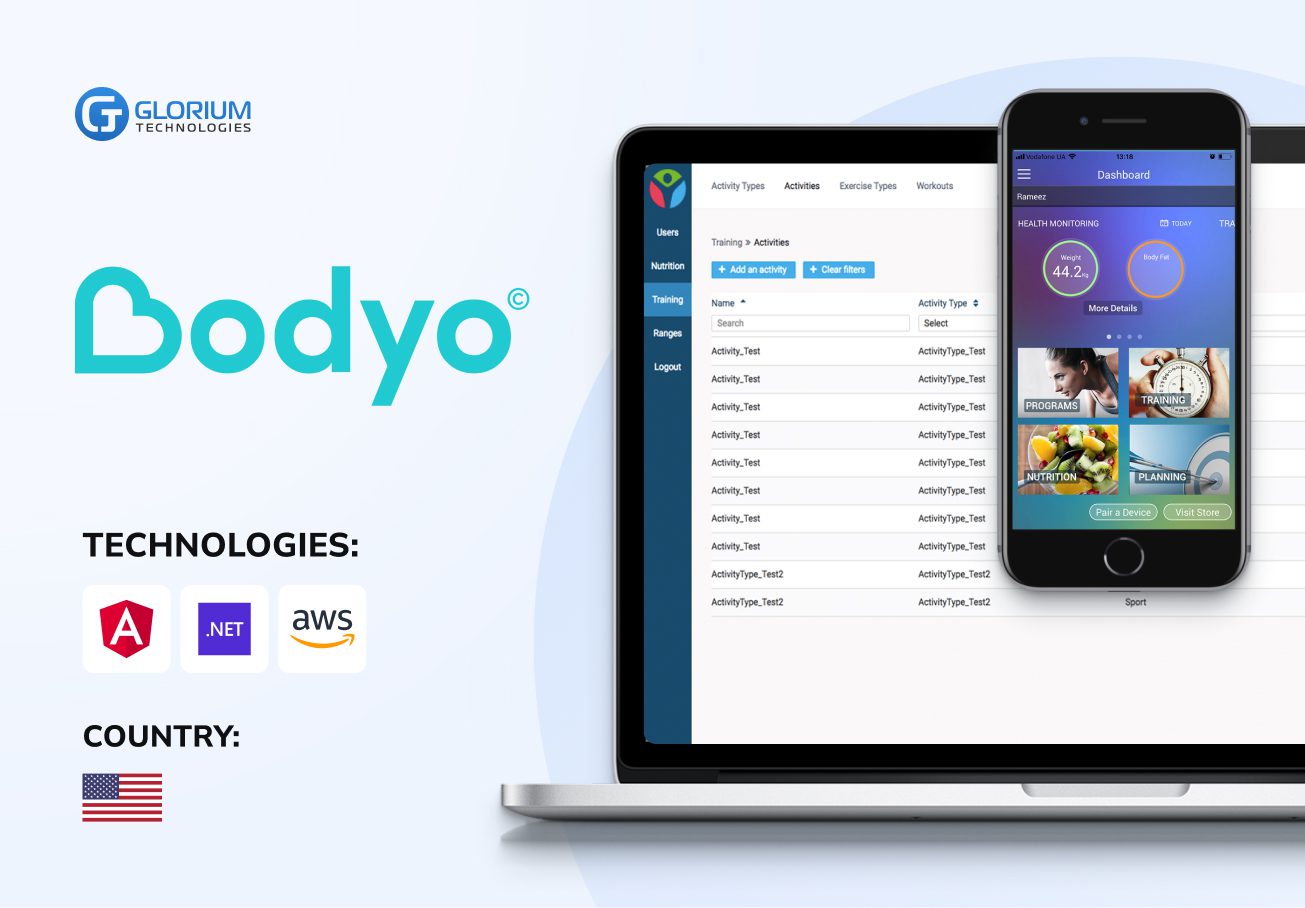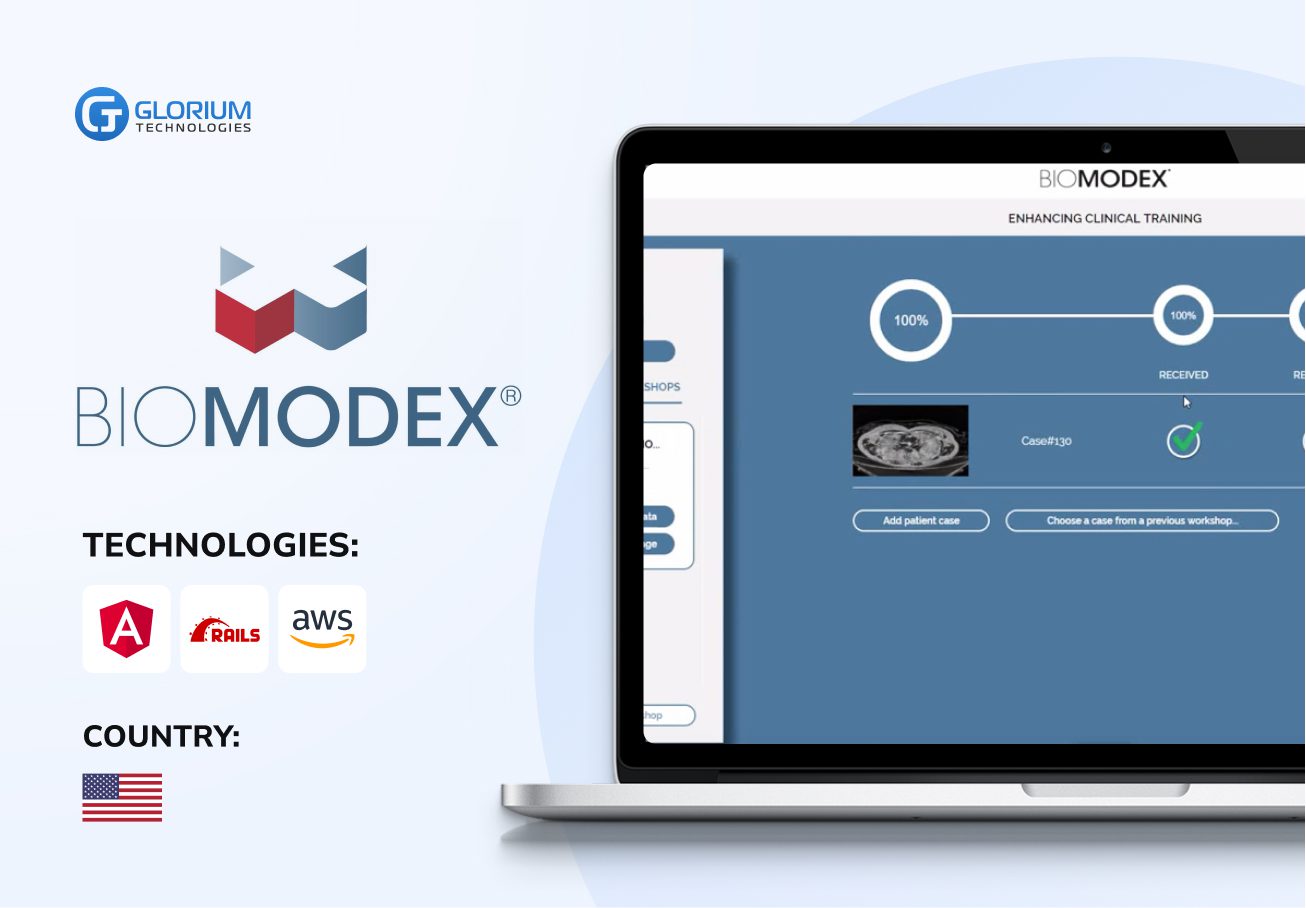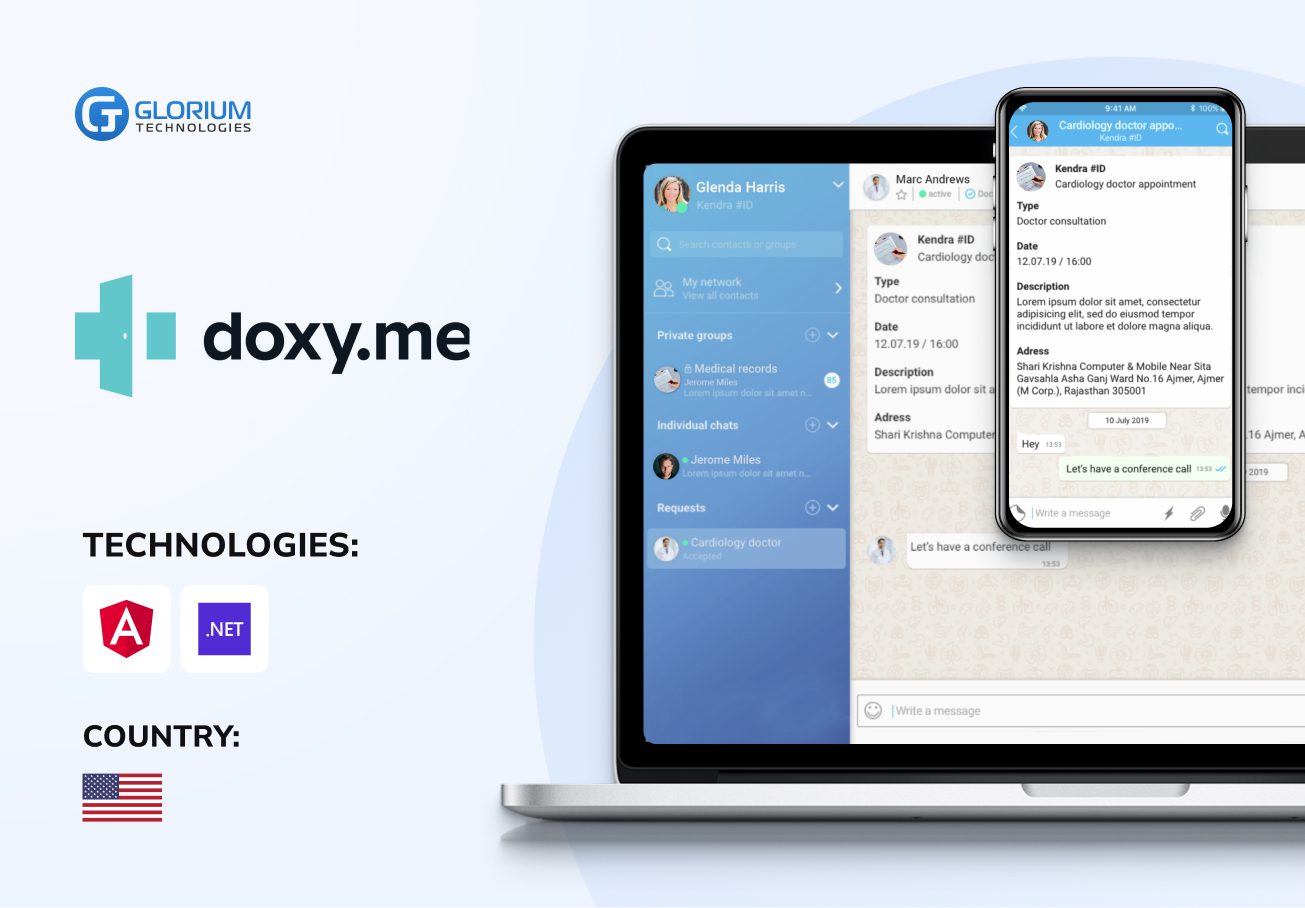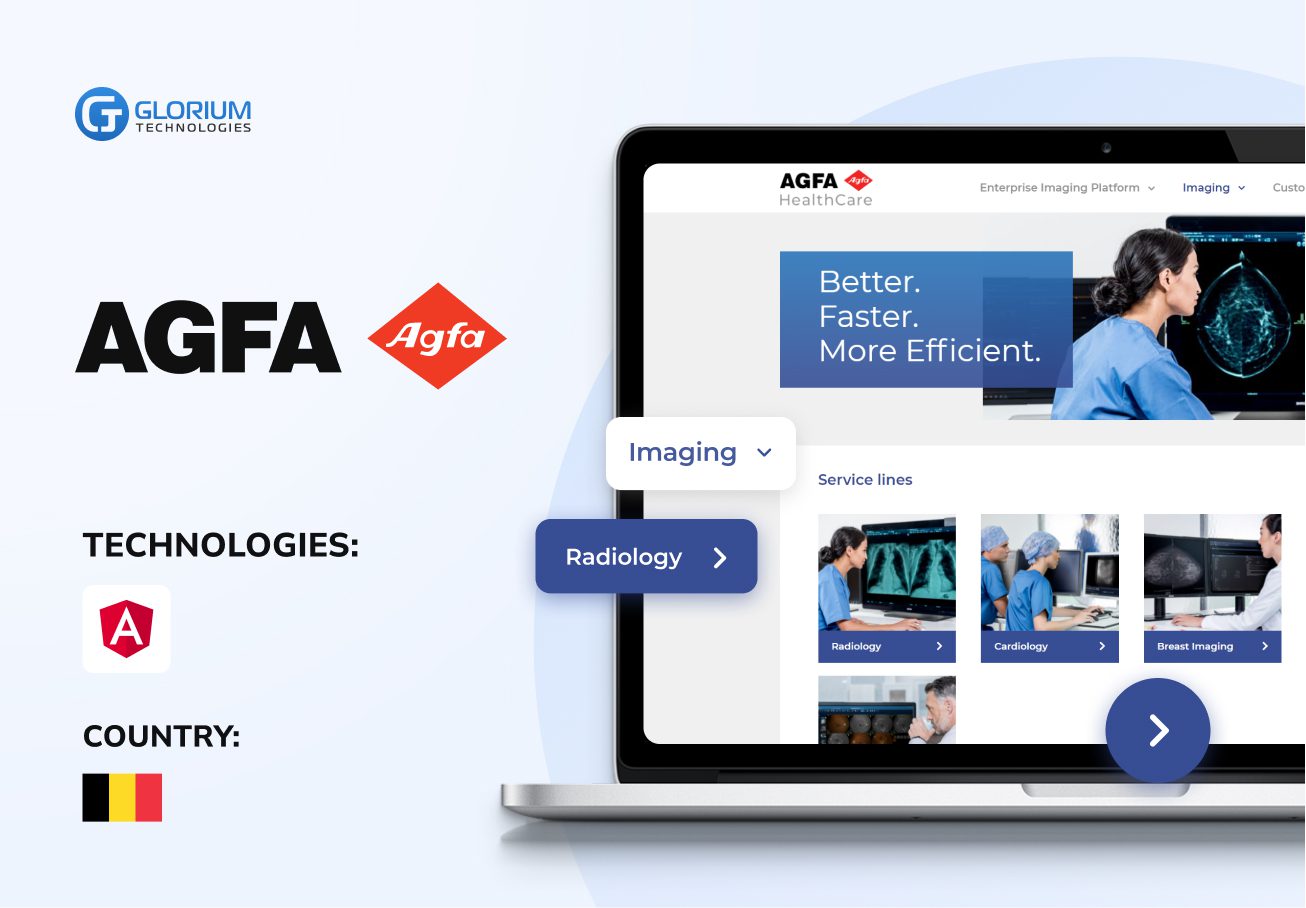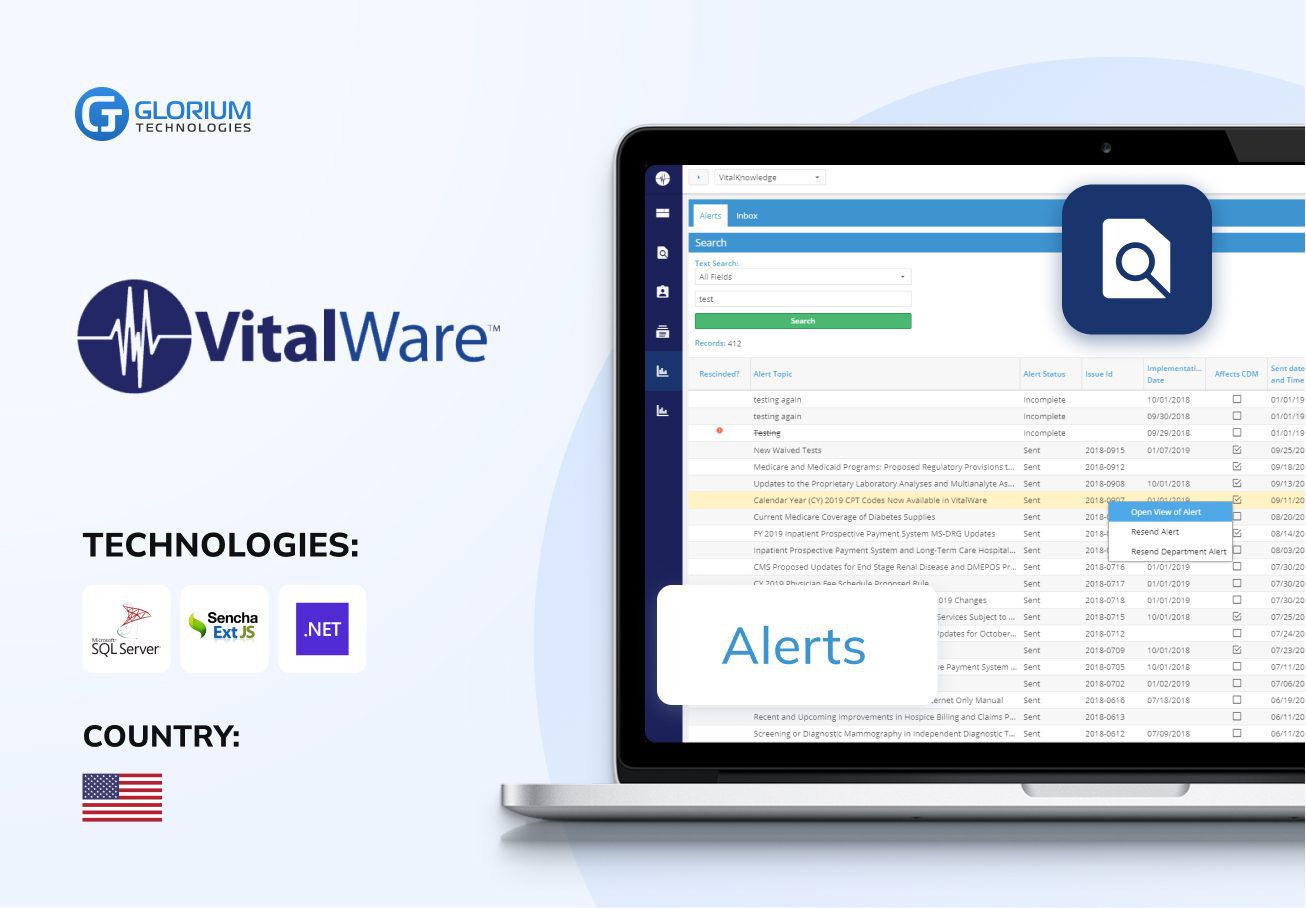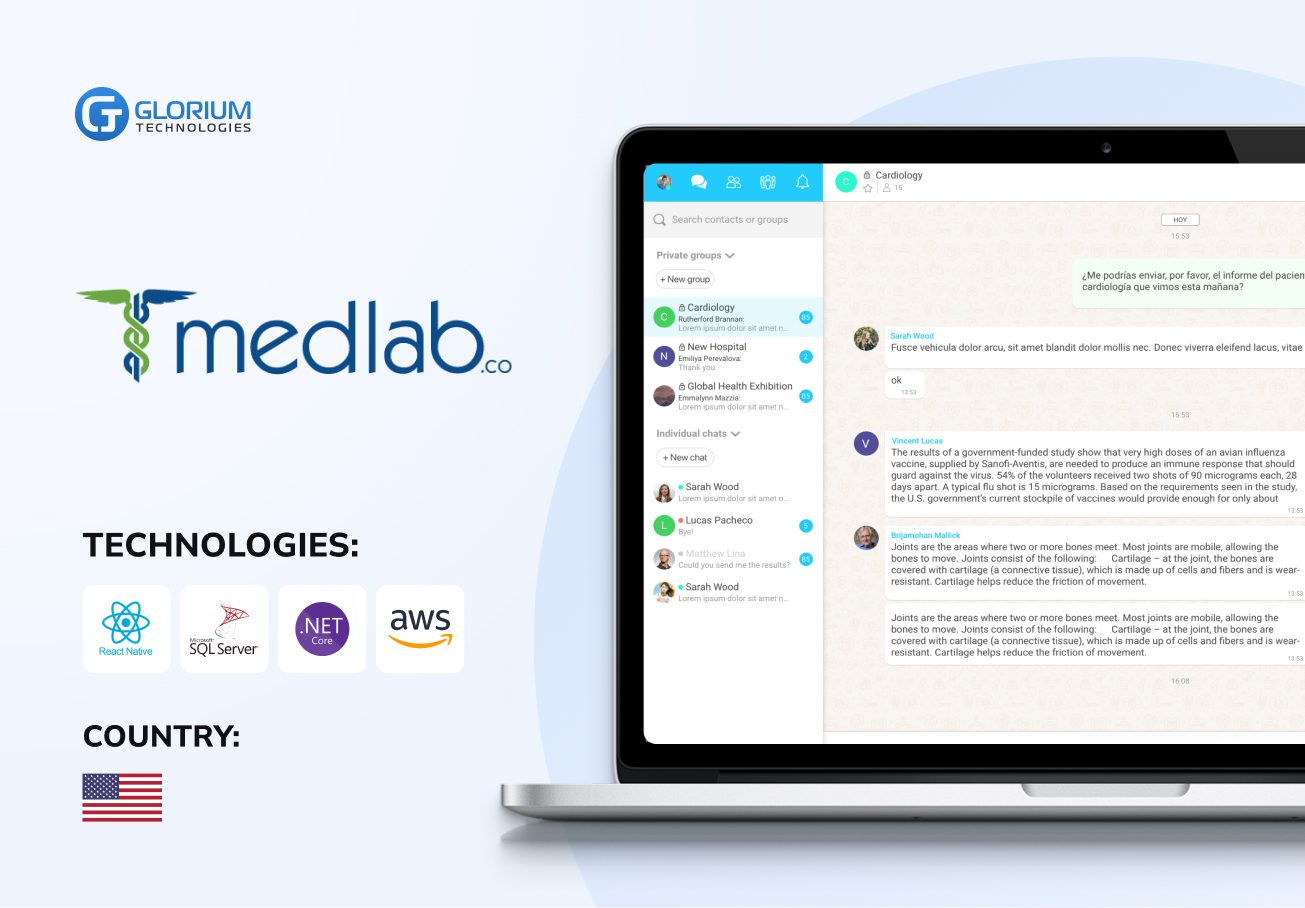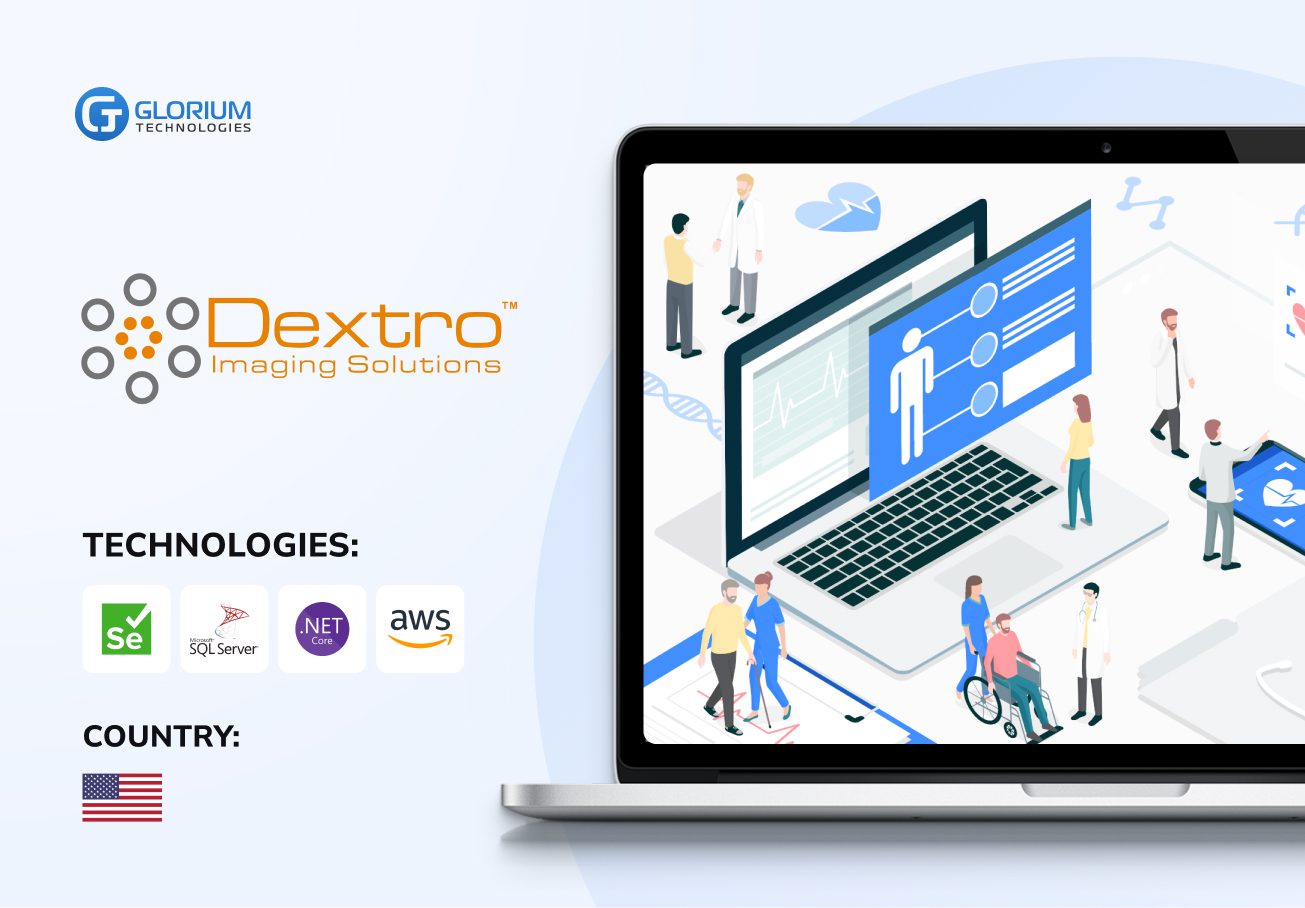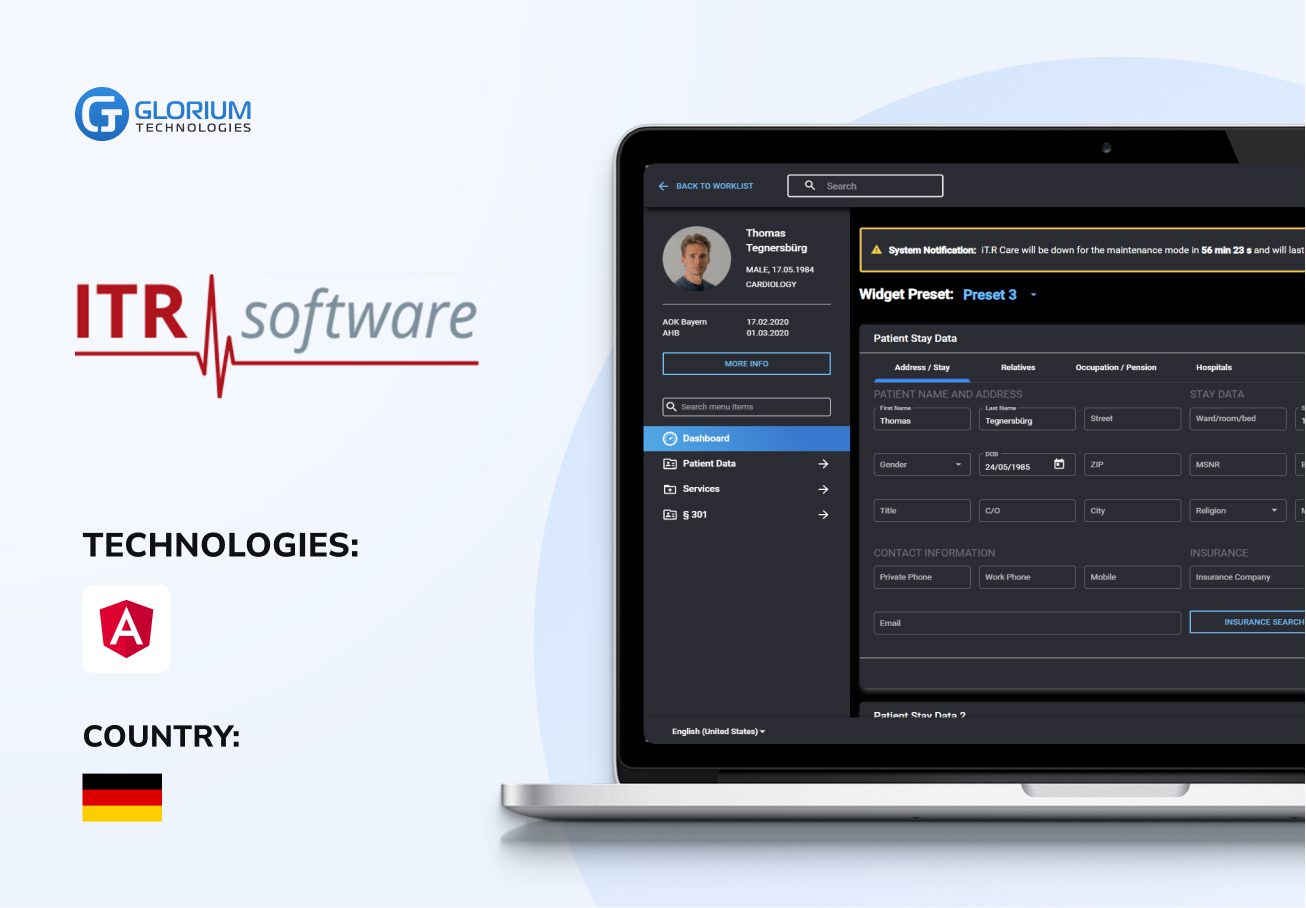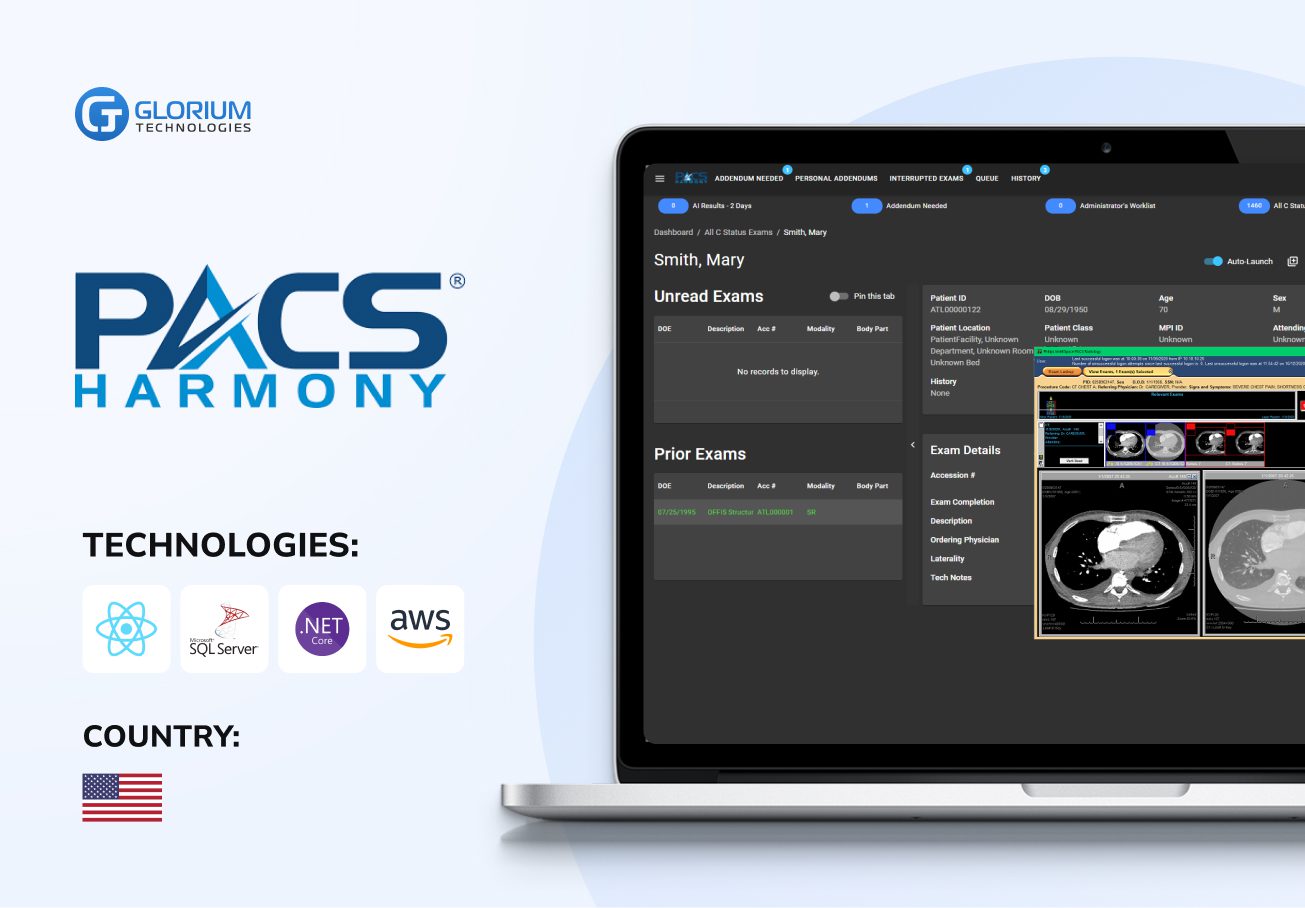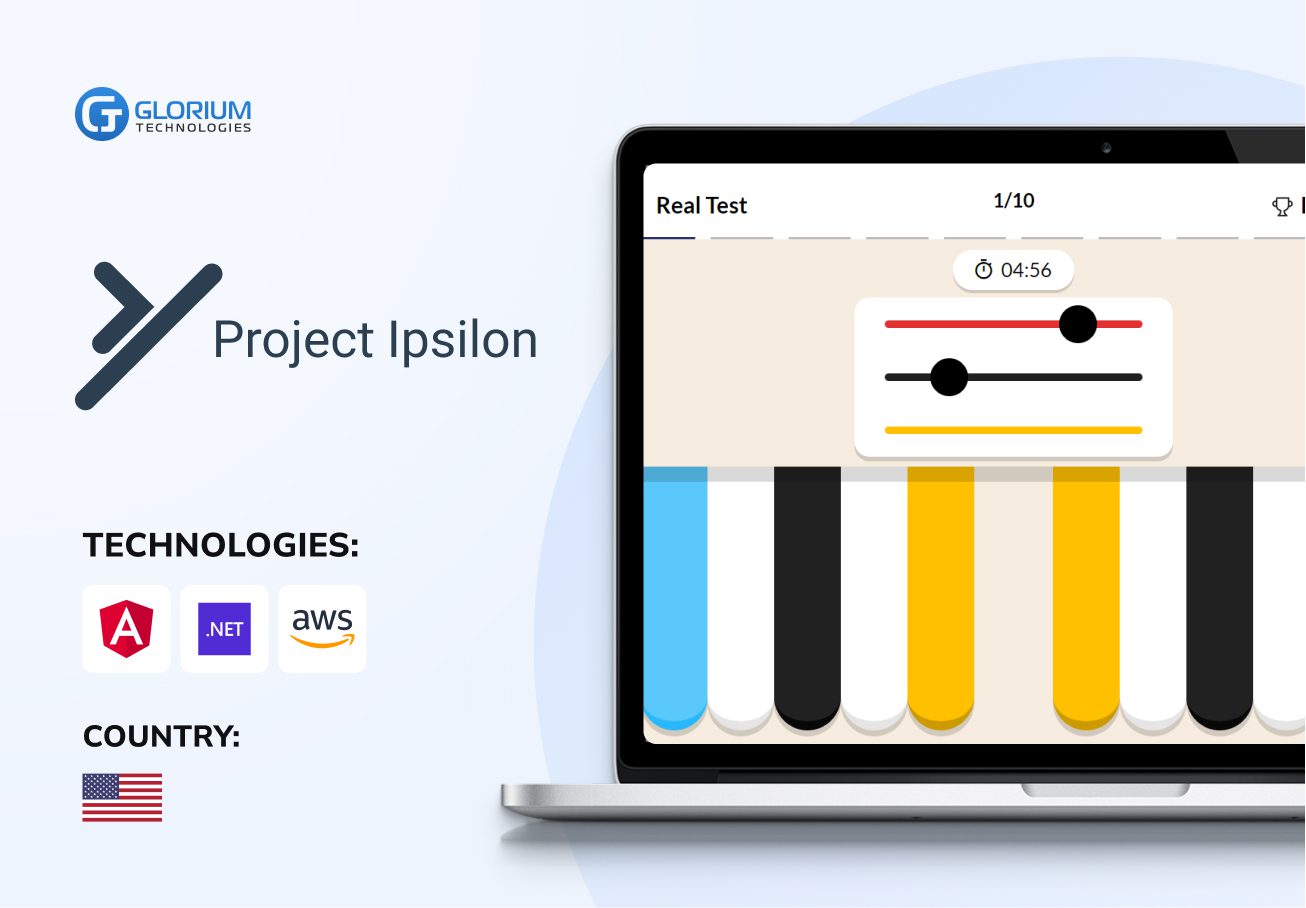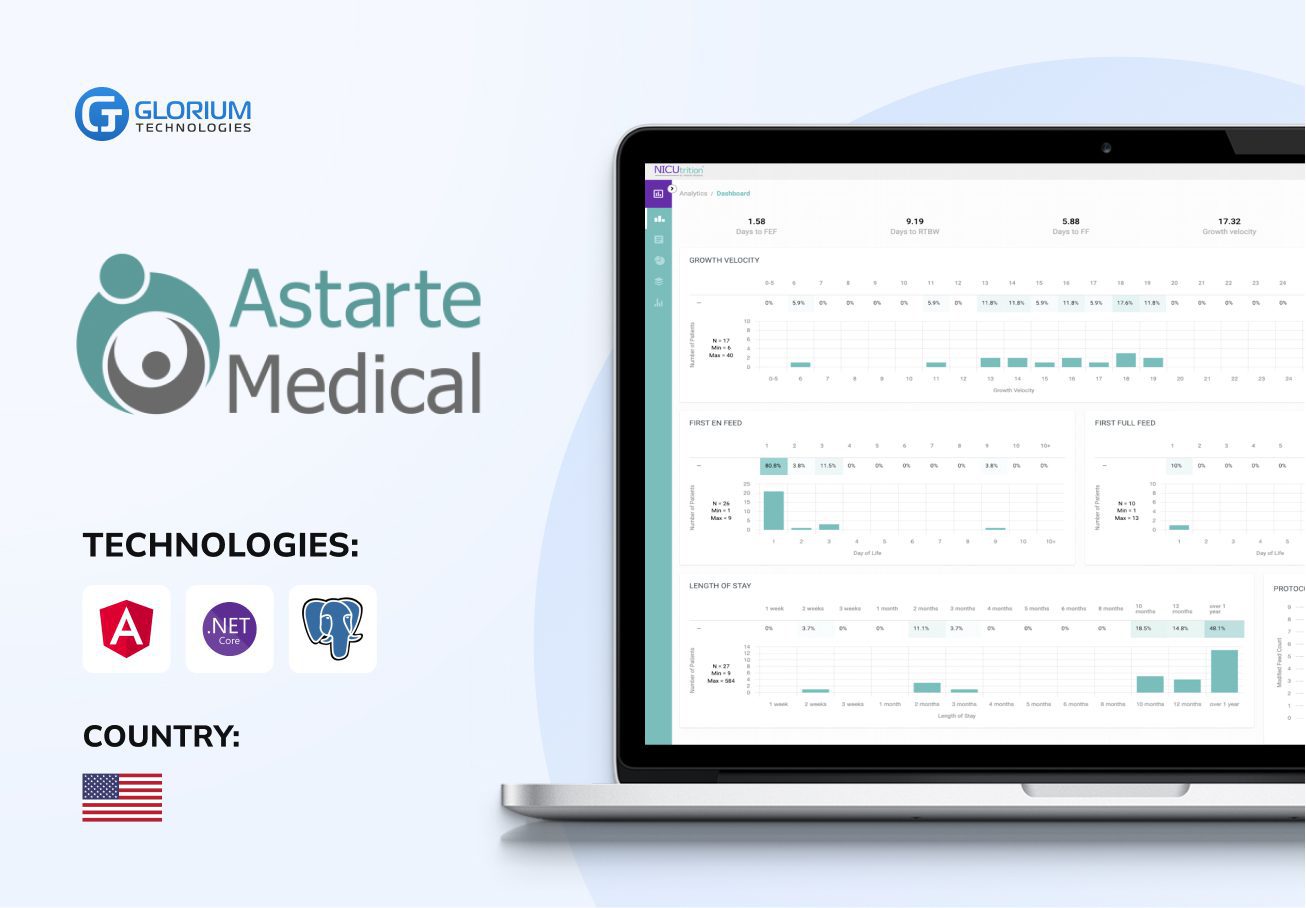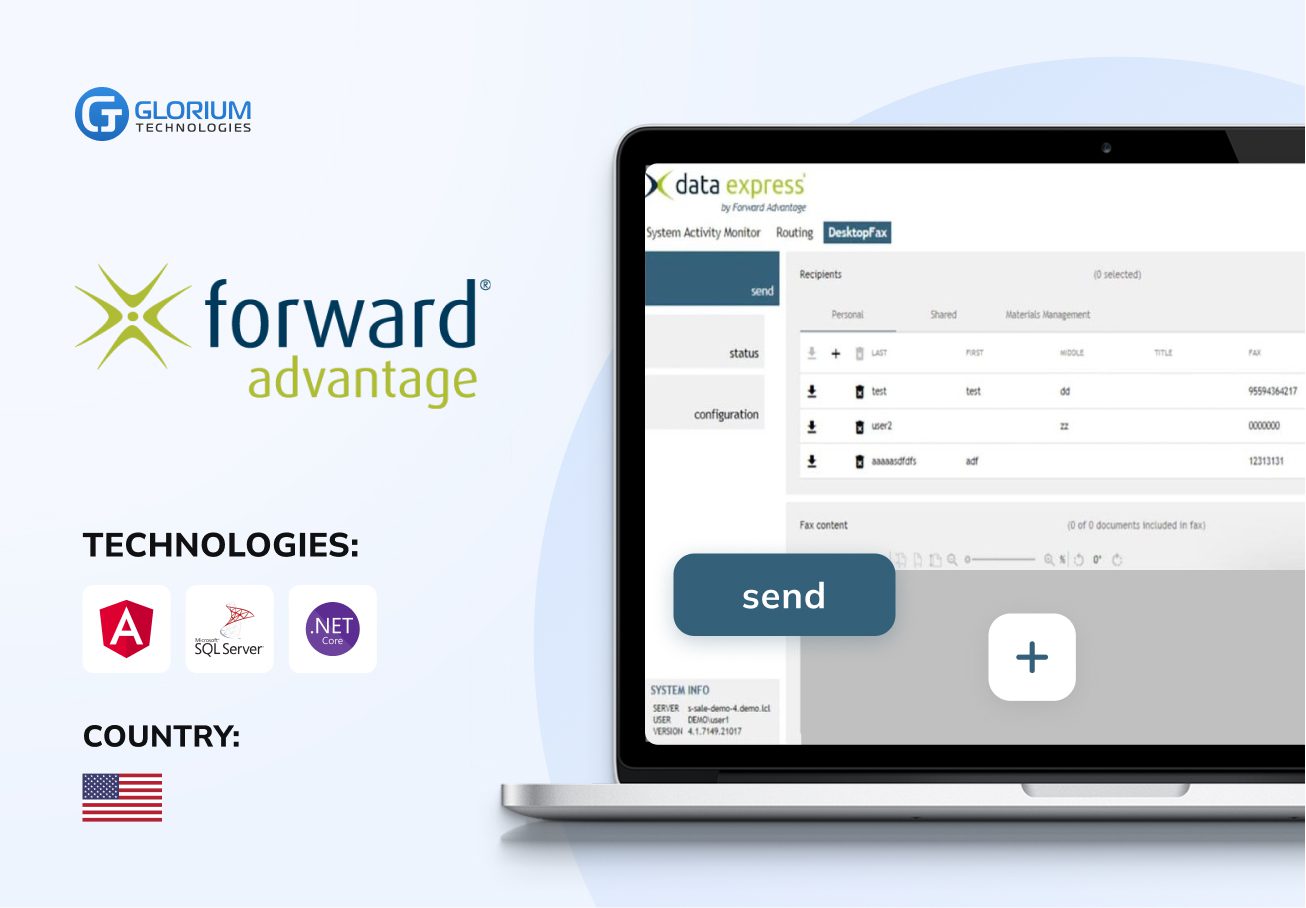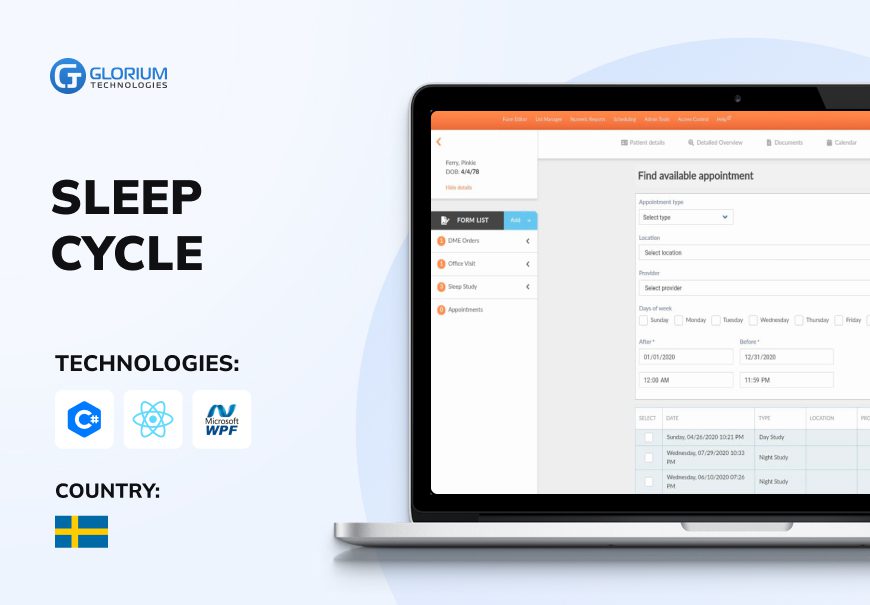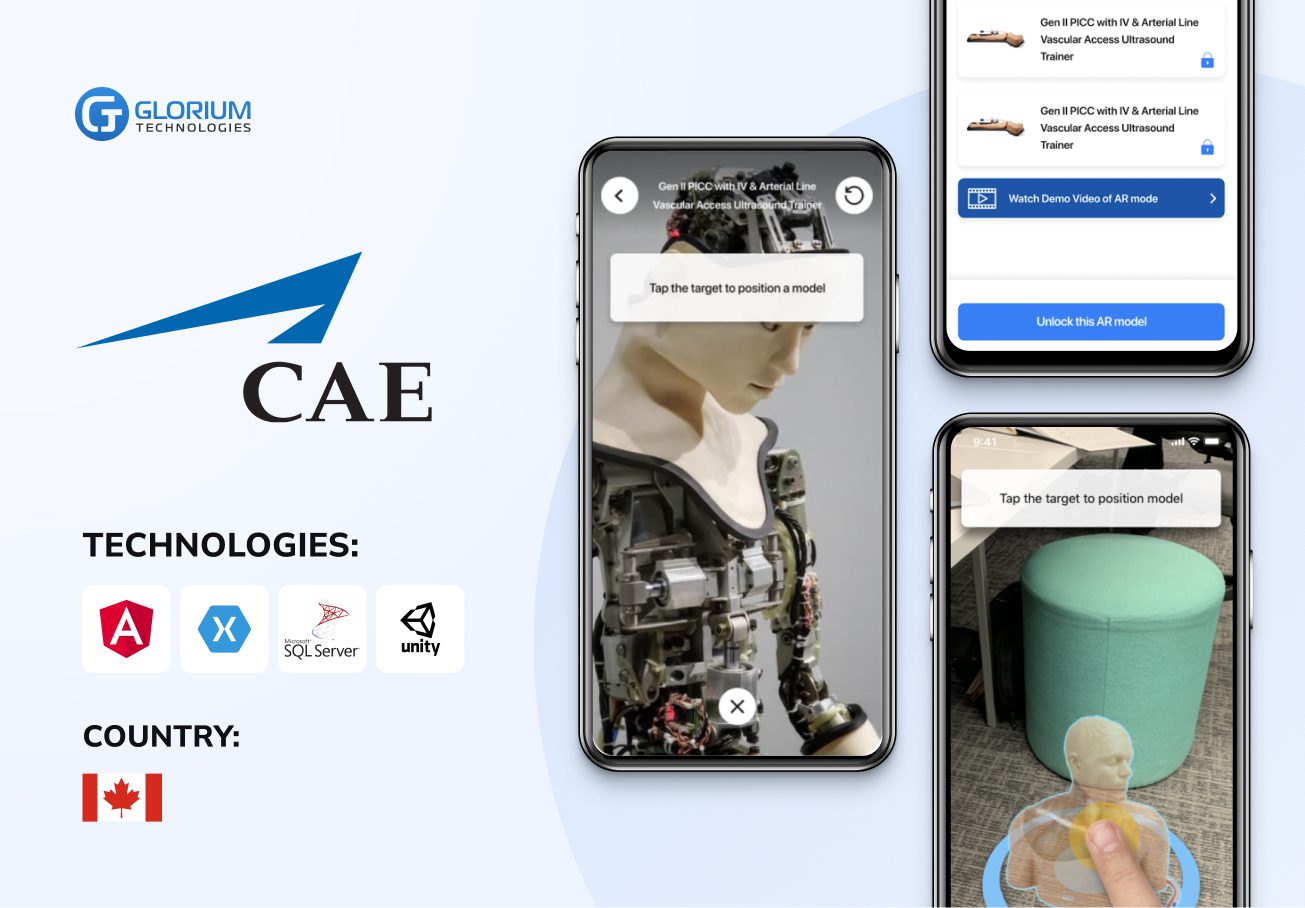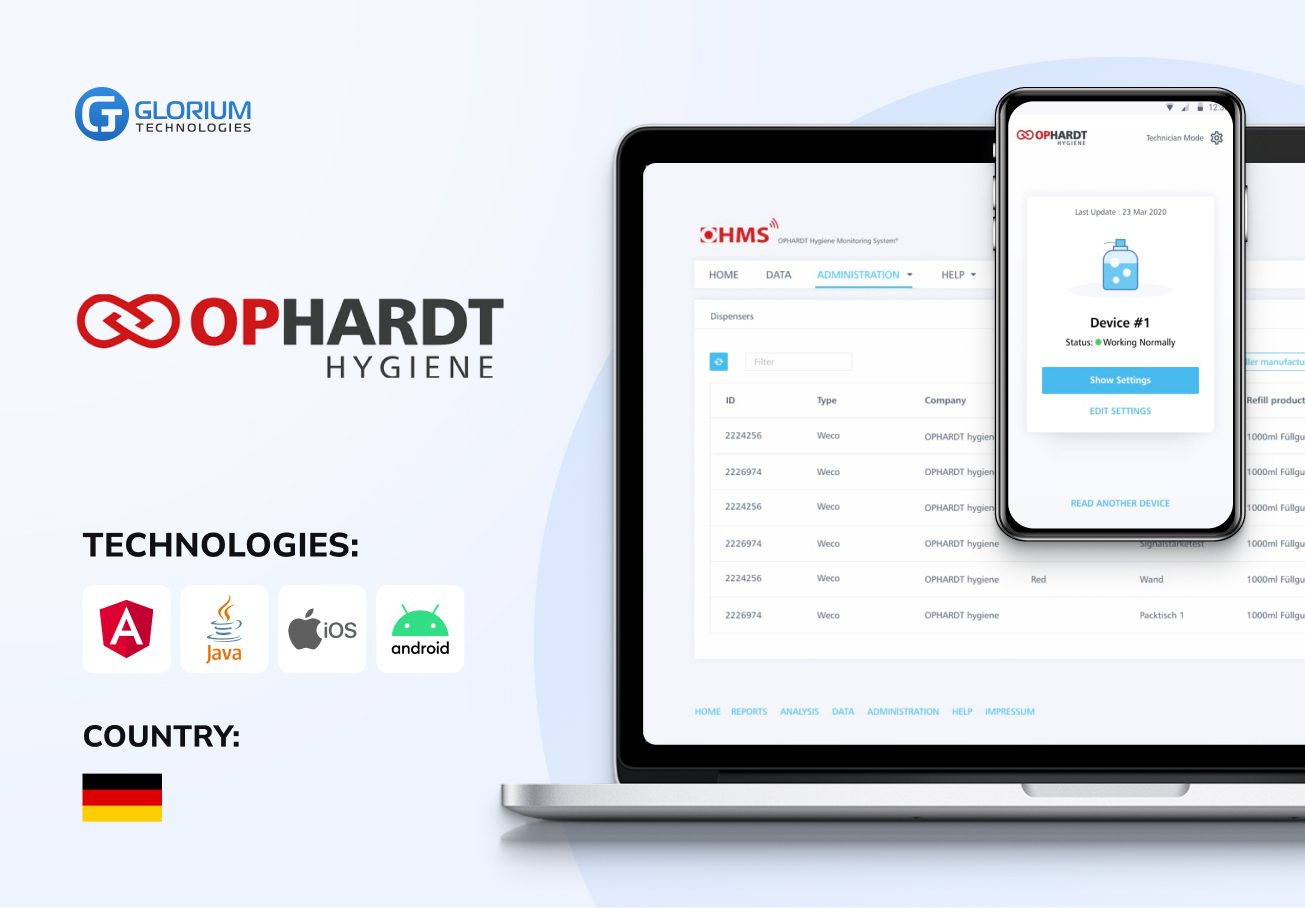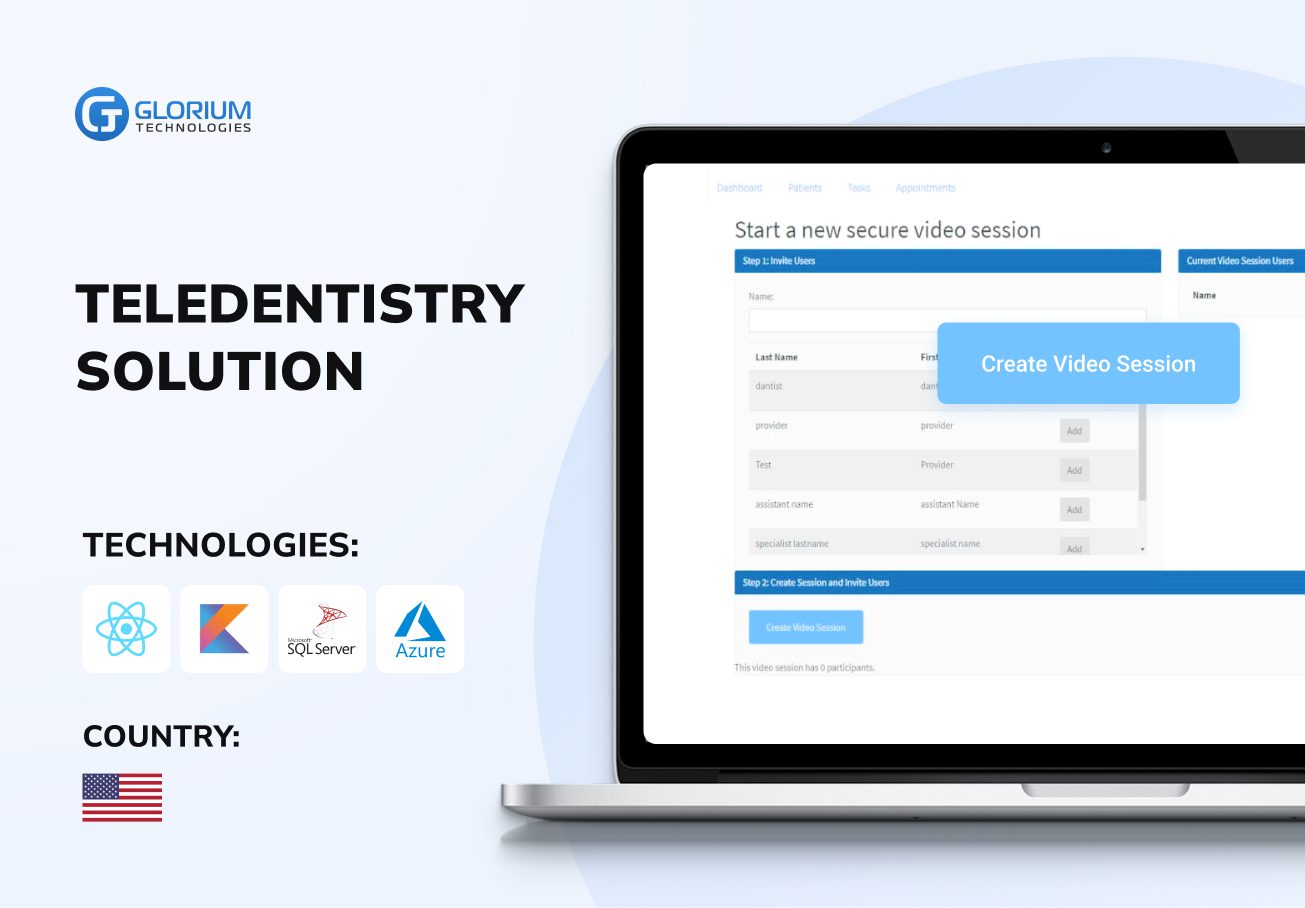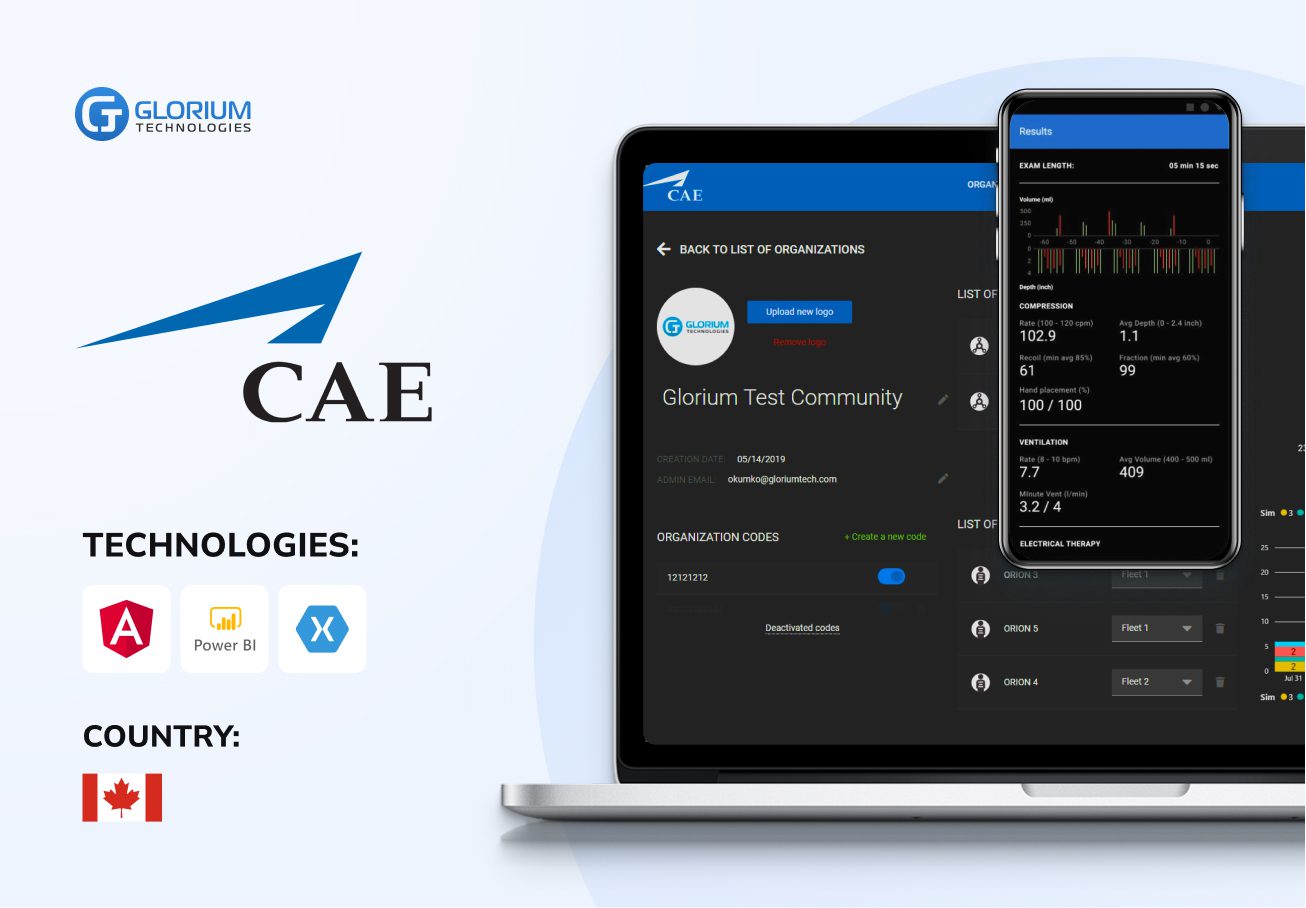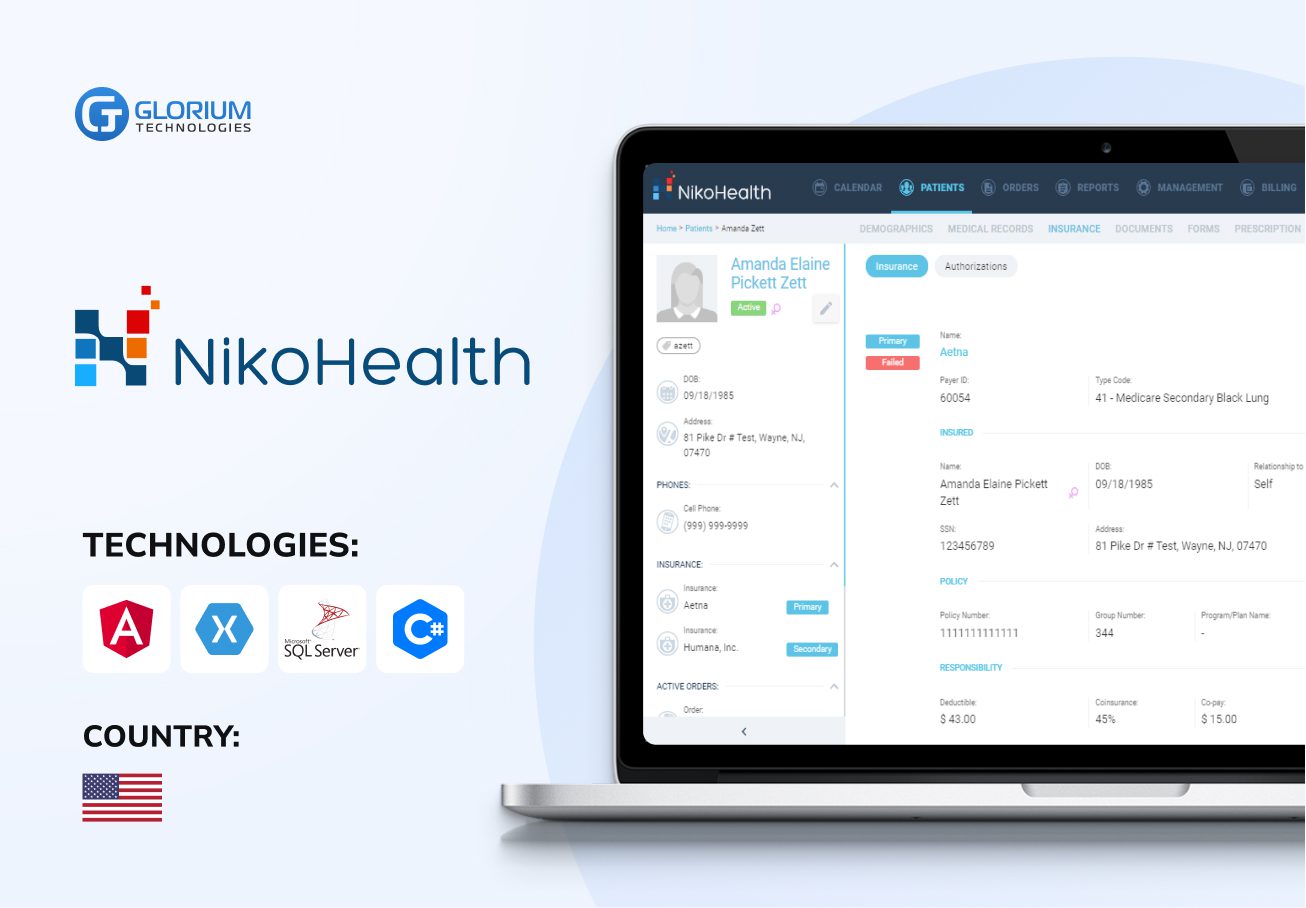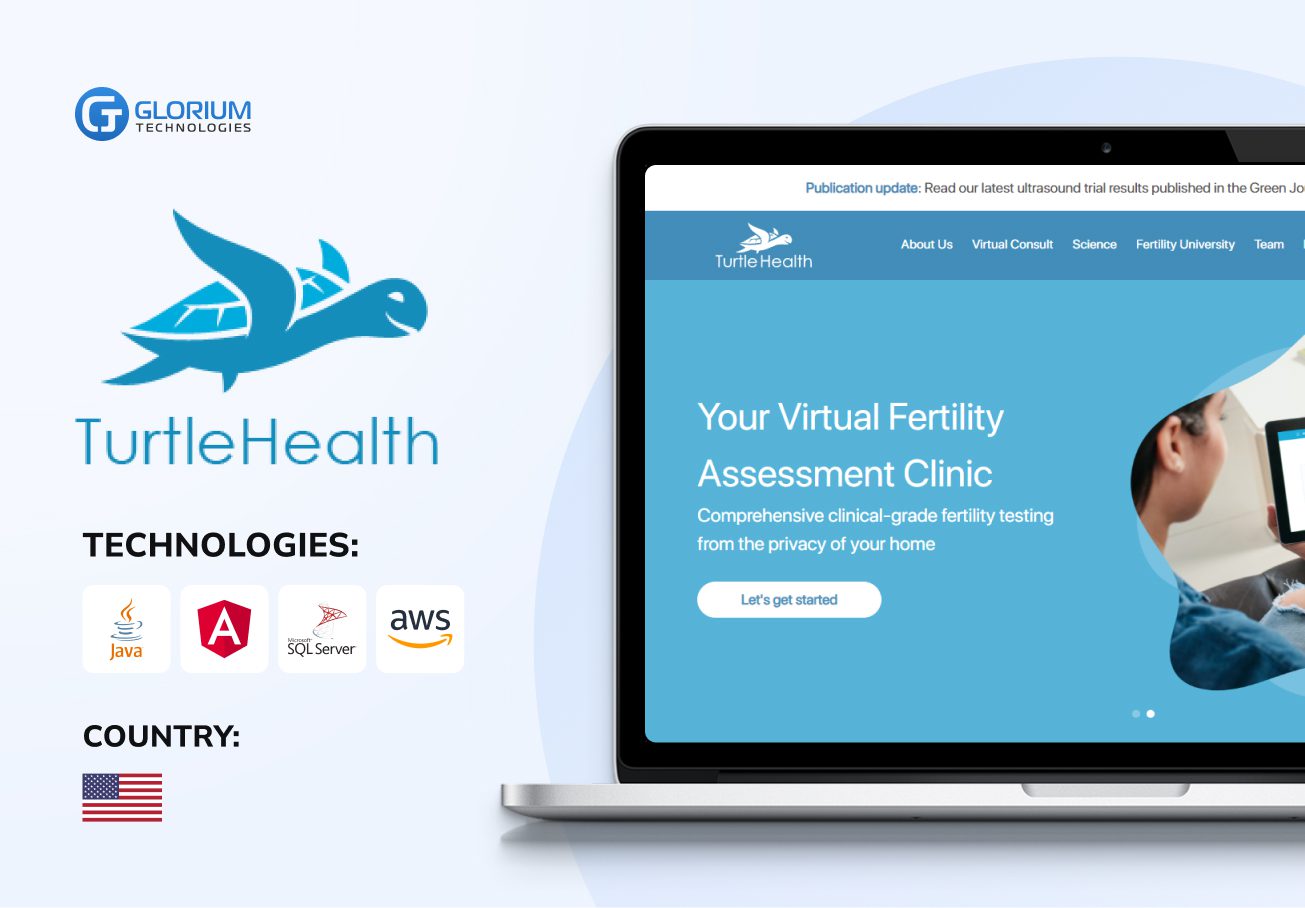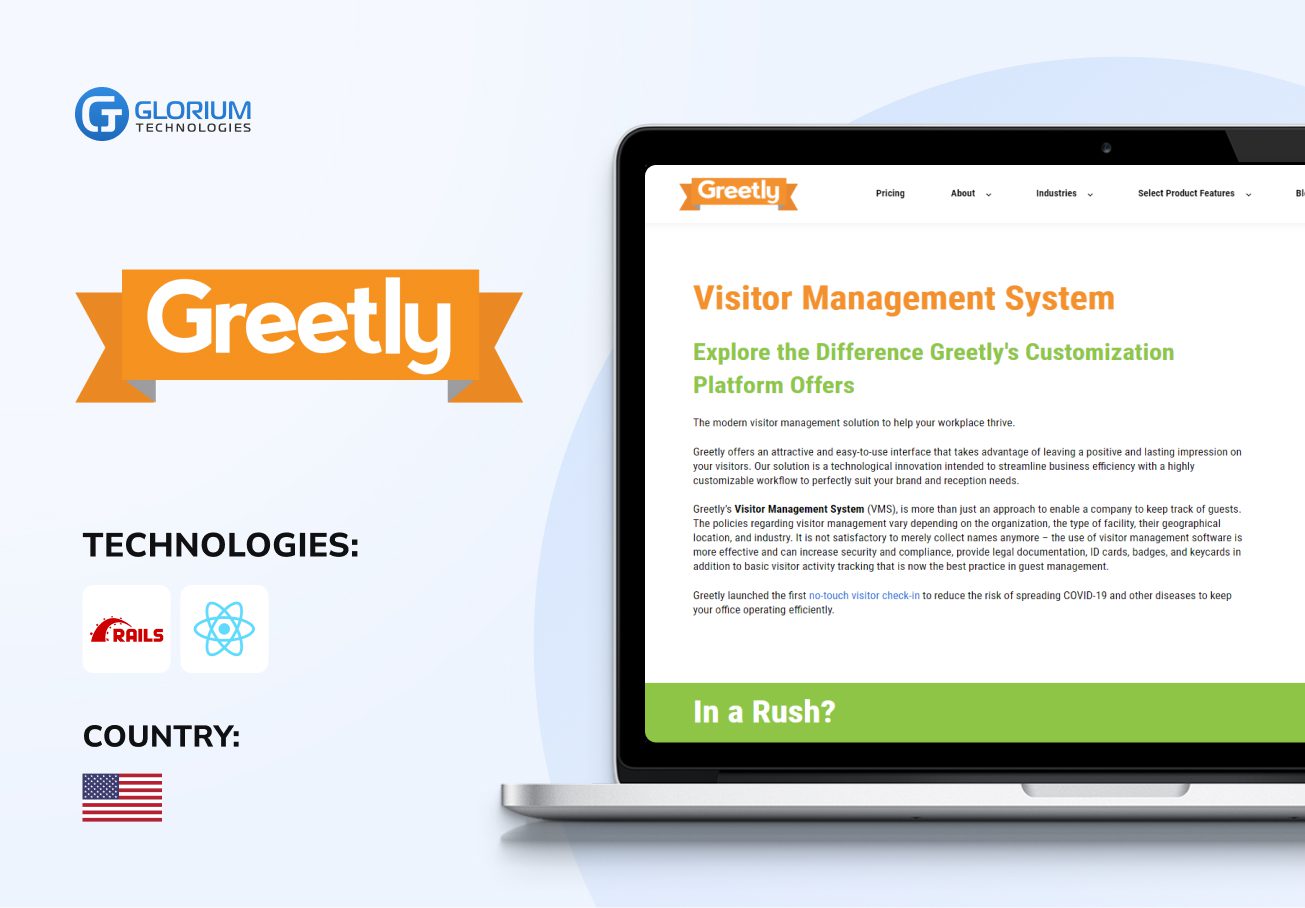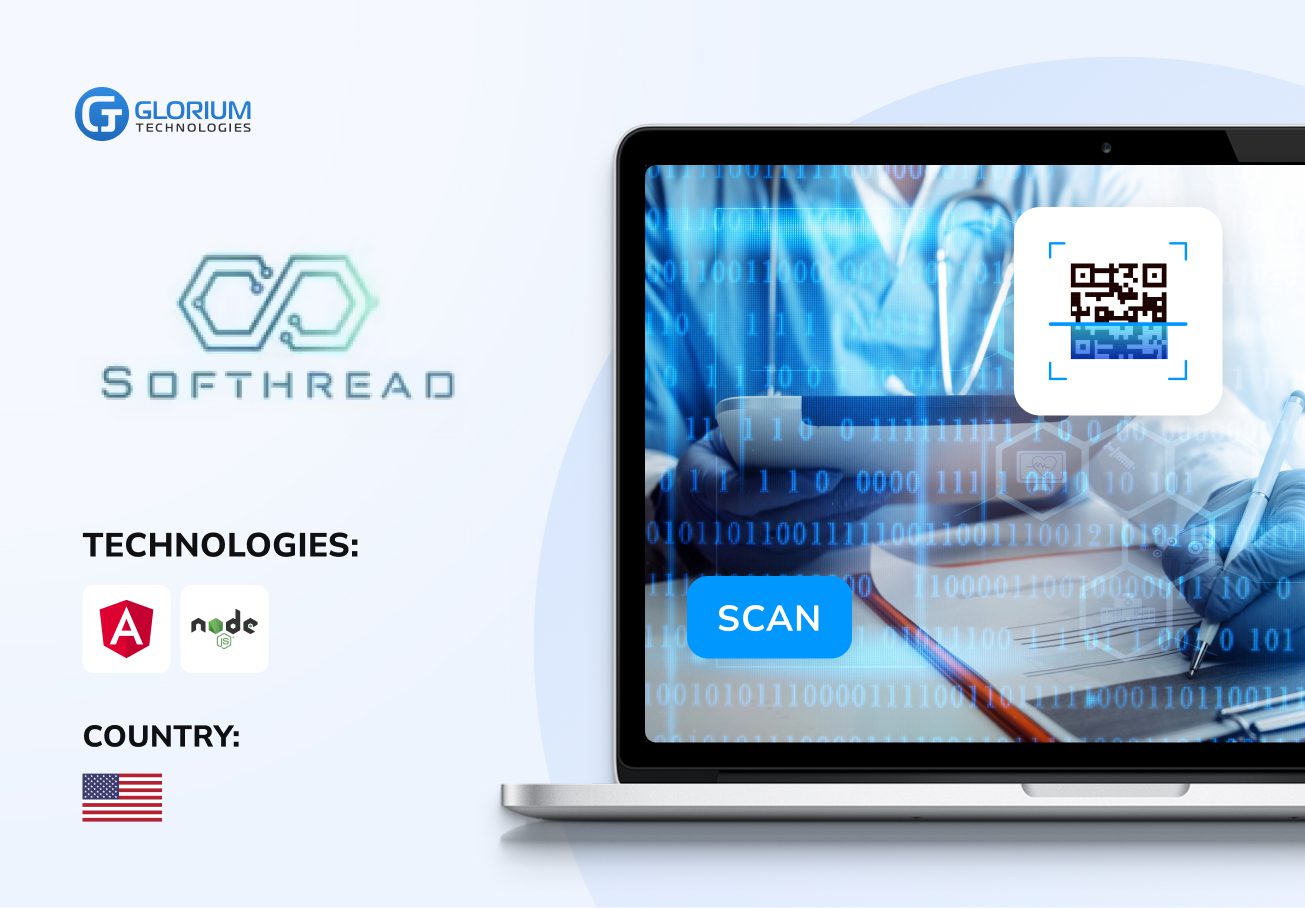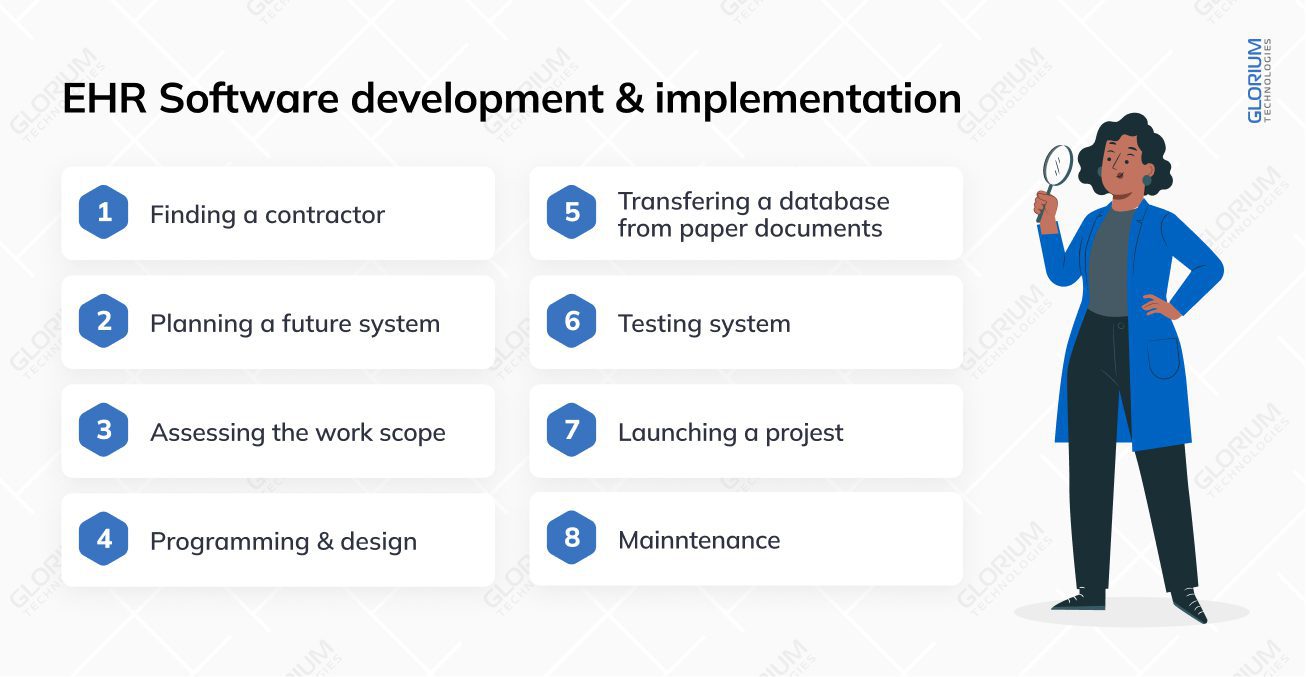EMR and EHR Software Development
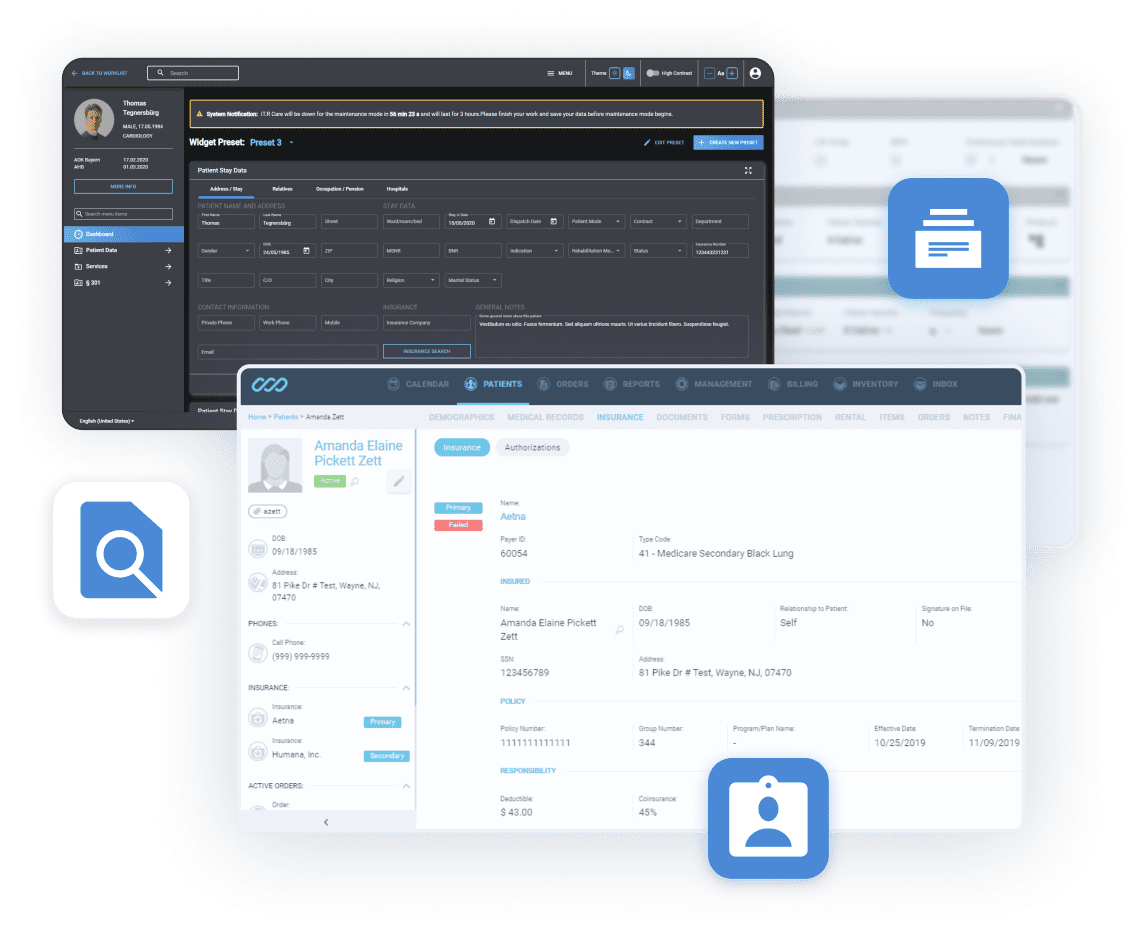

EHR Software Features
- Multi-tenant solution
- User-friendly UX/UI design
- Flexibility and universality
- Regulatory Compliance
- Support of multiple platforms
- Practice management software
- Patient portal
- AI-run chatbot
- Telehealth module
- Health information exchange
- Secure compliant cloud storage
- Self-registration and trial period
- Different user roles
- Billing features
- Customization
Benefits of EHR Software Solutions
- Comprehensive information storage for better treatment
- Saved resources, faster and more reliable delivery care
- Instant access to health records on demand
- Streamlined workflow and real-time information updates
- Enhanced transparency and integrity
EHR Development Services at Glorium Technologies
Integration
Recent healthcare clients

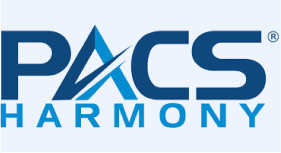


Our clients say about us
Our clients journeys
Who we are
Read moreGlorium Technologies is a full-cycle app & software development company which covers specific client business needs and manage them with the help of the best possible technology solutions.
Since 2010, we have been inventing digital breakthroughs, helping startups and businesses come out on top in their markets.

Why choose us
Custom EHR Software Development: Benefits, Features, Challenges
Healthcare organizations have long started optimizing their technology adoption to improve patient experience, comply with regulations, and stay ahead of the competition. Munich Re Life U.S. survey, conducted in 2022, highlights the growth of EHR software, reporting a rise of 38%. We saw even more growth in the following years, and experts predict that even more healthcare facilities will adopt EHR software and EMR systems.
Why does this happen?
Well, for starters, healthcare companies want to improve their patient data collection, assessment, and usage methods, optimize their workflows, and comply with regulatory standards. On the other hand, an increased number of phishing attacks on healthcare organizations (45% U.S. in 2021, according to Statista) urge companies to opt for encrypted cloud computing and security measures.
Long story short, EHR software development opens doors to many opportunities. Of course, there are challenges and specific processes for EHR adoption, and that’s what we want to explore in this article.
Overview of the EHR System Market
Electronic health records are a must-have and in great demand in modern medical practice. Grand View Research, in its market research report, valued the EHR market at $28. Even with the growth and development of new healthcare solutions, the basic purposes of applications have not changed. But, the existing software systems still do not fully satisfy the users’ needs and requirements.
About 42% of doctors and medical personnel have stated that they are not satisfied with the current EHR software. The pandemic and the growing digitalization require improved, interconnected, secure, and effective EHR and billing software.
So, what is an EHR system? We don’t usually include theoretical explanations and boring content, but electronic health records systems are complex necessities, so we need to explore them a bit more.
EHRs are a type of patient-centered, real-time health records created for easy access and retrieval of information. They gather and organize patient health information, which helps healthcare companies to oversee and analyze this data for better patient experience.
EHRs can include:
- Medical history
- Diagnoses
- Medications
- Immunization dates
- Allergies
- Radiology images
- Test results
- Demographic and billing data
An EHR system can also communicate with other healthcare entities. It can encompass all forms of facilities like ERs, labs, specialists, diagnostic centers, pharmacies, and workplace clinics, and thus, they are part of the patient journey.
Types of EHR software solutions
Since you’re looking for a suitable EHR software for your company, we recommend first understanding the categories of EHRs based on their features, deployment methods, and service scopes:
- On-premise EHRs: On-premise EHRs are hosted on the provider’s server and are maintained by the provider’s IT department. Such EHRs will provide you with an opportunity to customize it; you will own the data and integrate it with other systems easily. Keep in mind that they also require significant capital investment in hardware, software, and personnel
- Cloud-based EHRs: Cloud-based or SaaS EHRs, which are stored on the vendor’s server and accessed through the internet, are relatively cheaper to implement with a subscription-based model. They are scalable and can be accessed remotely but are not very customizable and depend on a stable internet connection
- Integrated EHRs: Such EHRs are designed to contain practice management functions such as billing, scheduling systems or patient portals to help manage other administrative duties in addition to improving the data quality. Different providers offer different integration levels, so the cost will vary
Benefits of EHR implementation
Selecting the correct category and adhering to the steps in the EHR development process will allow your organization to optimize its processes, increase market position, and increase the overall effectiveness of business processes.
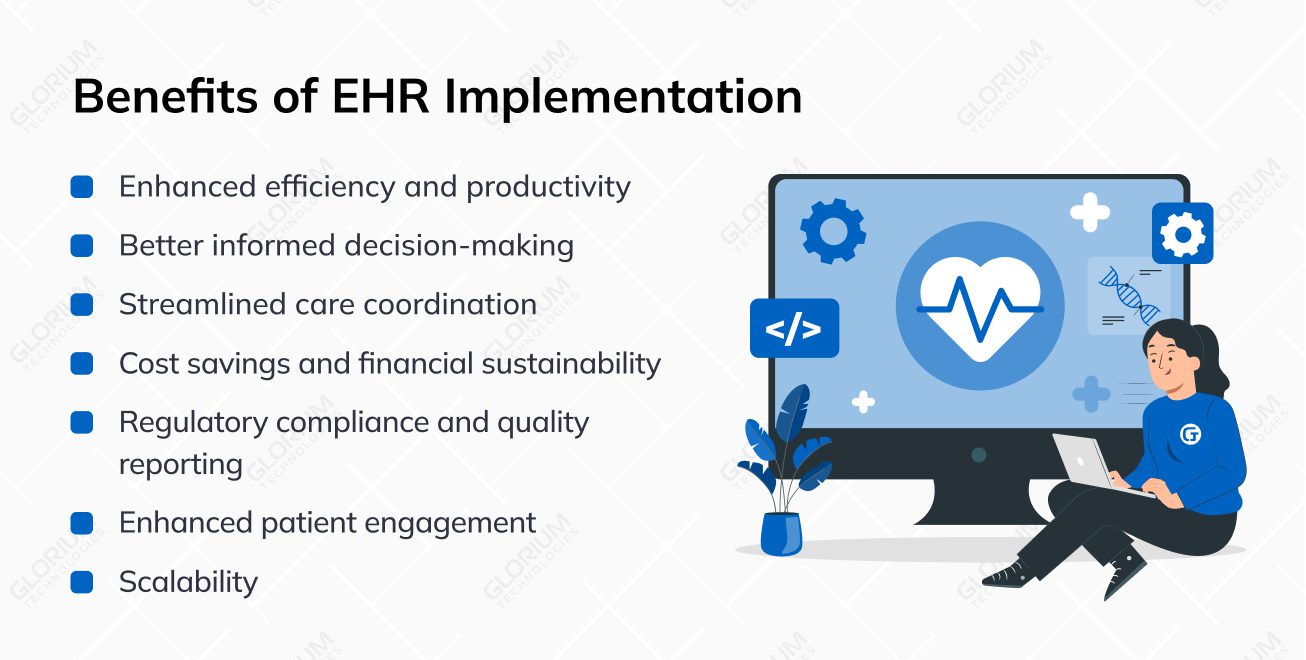
- Enhanced efficiency and productivity: EHRs allow for the automation of tasks such as appointments, orders, prescriptions, and billing, which means that the workforce can attend to patients. EHR software can also increase efficiency and allow more focus on the patient instead of paperwork and other non-nursing tasks
- Better informed decision-making: EHR software provides healthcare organizations with details of patients’ previous history, such as allergies, medication, diagnoses, and test results. Hence, this data enables informed decision-making, which is vital for patient outcomes
- Streamlined care coordination: EHRs help in the easy transfer of patient data across the different providers, departments, and institutions, thus improving care coordination
- Cost savings and financial sustainability: Although there is an initial capital outlay to acquire EHR software, it is more economical in the long run due to reduced costs on paperwork such as printing and filing, duplicate tests, and reduced errors
- Regulatory compliance and quality reporting: Healthcare enterprises are subject to significant legal requirements and increasing standards concerning quality measures. Custom EHR software helps providers meet these measures and improve quality reporting has been developed
- Enhanced patient engagement: EHR has a patient portal where patients can access their medical records, book an appointment, request a refill of medication, and communicate with the provider – educating patients and increasing the level of their engagement
- Scalability: Since healthcare companies are often growing, they require systems that can be easily scaled up. EHR software has its inherent scalability; it is easy to add users, departments, or locations depending on the organization’s needs
EHR Software Features
There are numerous features in EHR software that help in improving the efficiency of the clinical processes and meet the legal requirements:
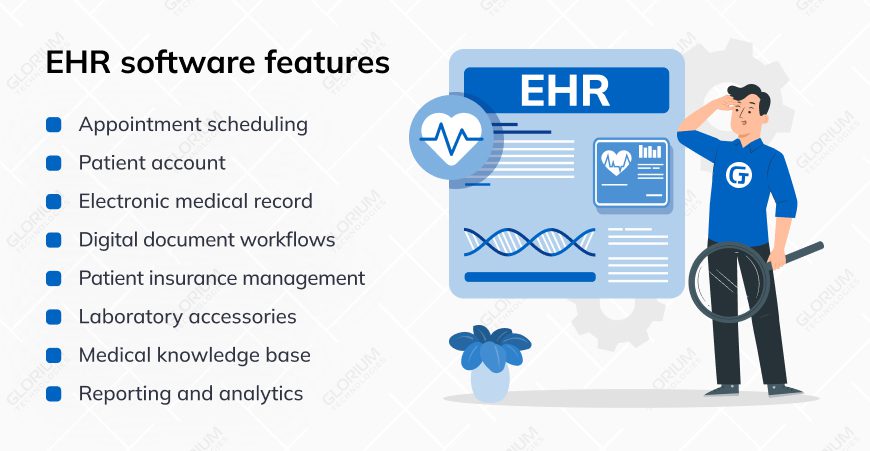
- Appointment scheduling: This feature promotes real-time viewing and editing of provider schedules, appointment bookings, and even reminders. This eliminates most of the paperwork in healthcare facilities and, in turn, improves the patient’s health experience
- Patient account: Adding this feature will dramatically improve the patient onboarding process
- Electronic medical records: Enables medical documentation of examinations such as initial examination, epicrisis, and diary entries, registration of patient diagnostic data, and registration and storage of medical appointments
- Digital document workflows: Everything from the patient intake and medical consent forms to different agreements has to be done digitally
- Patient insurance management: Enhances business process management with insurance companies
- Laboratory accessories: Helps in the automation of communication within a laboratory, as all information is synchronized with a patient’s profile
- Medical knowledge base: Allows doctors to have the updated treatment and diagnostic guidelines they need
- Reporting and analytics: EHRs contain modules for producing custom reports and data analysis for the clinical management of patients. These support quality improvement, compliance, and strategic management functions
EHR Development Challenges and Solutions
Even though EHR software is aimed at optimizing the work of healthcare organizations, the introduction of such a system is not without considerable pitfalls.
Healthcare regulation compliance
Challenge: In healthcare, the legal frameworks that influence EHRs include HIPAA and GDPR, which address issues to do with patient privacy, data security, integration, and communication. It is important to comply with these regulations, as any form of violation attracts severe penalties.
Solution: Partner up with custom EHR software development companies that are conversant with the regulations. They create systems that address legal frameworks and change software as required. Proper orientation of employees on the requirements of regulations leads to reduced risk.
Interoperability issues
Challenge: Although the health information exchange standards exist, EHRs experience data sharing difficulties, thus incomplete patient information.
Solution: Selecting an EHR system that is compatible with interoperability standards, such as HL7 or FHIR, can be helpful. Moreover, cooperation with other healthcare providers and IT suppliers can improve data exchange.
Usability and training
Challenge: It is not uncommon to hear that EHR systems are hard to use and this makes the healthcare providers unproductive and unhappy. This can be due to the fact that the interface is too complicated.
Solution: Choosing custom EHR software with a smooth and easy-to-use interface can help avoid this problem. Also, it is imperative to offer routine and extensive training to all users of the EHR system to enable them to use it properly.
Data security and privacy
Challenge: Since EHR systems contain patients’ information, they are vulnerable to cyber threats. The legal and financial implications of data breaches are dire and can damage the credibility of the organization.
Solution: Some of the important measures include encryption, secure user authentication, and regular security audits. In addition to these, security practices for the staff and keeping all the software updated can also help to minimize the risk.
High implementation costs
Challenge: Acquiring and implementing an EHR system is costly, as it involves software, hardware, staff training, and general upkeep.
Solution: Cloud-based EHR systems may be less expensive in terms of initial investment and may be more suitable for small practices. Also, strategic management and proper financial management can be used to get the desired return on investment in the future.
EHR implementation issues
The process of EHR implementation and selection is a complicated and time-consuming process that demands a lot of effort and money. Hence, it is necessary to ensure that the program you select meets CFM standards and is created by a reliable company with a positive image among market players.
With correctly implemented EHR system, your company will feature a competitive advantage:

Many hospitals have adopted electronic health records and medical billing software. However, there are issues with implementation and patients and staff struggle with new applications and programs.
To address this problem, healthcare software developers pay close attention to the design of certain features that are aimed at easy integration and increasing the product’s appeal.
Integration with EHR: what a medical billing solution should contain
The billing process is a crucial aspect of healthcare services; therefore, it becomes essential to have a proper system that can handle claims, code management, and analytics in medical practice.
Advanced billing systems manage the creation of billing documents and charge posting, which means that financial processes are accelerated and monotonous tasks are eliminated.
Integration
The first important aspect of medical billing software should be an adaptable and interactive integration that allows for efficient financial work in an EHR system to be done.
If there is no proper way to link the system with an EHR system, the billing process will be very cumbersome—this is not the intended goal.
Medical billing codes — tracking & processing
HCPCS (Healthcare Common Procedure Coding System) and CPT (Current Procedural Terminology) are code sets that are vital in medical billing.
Every service that a clinician offers is given a code to help with tracking and billing. These codes also set the rate of reimbursement by the health insurance organizations.
Thus, coding errors cost healthcare organizations approximately $15.95 billion, states the CMS (Center for Medicare and Medicaid Services). Disclosing the 2019 figure, the organization said it dealt with $1.73 billion in incorrect payments. Thus, it is crucial for medical software to provide compliant, accurate code lists and make code assignment and processing a part of the system’s operations.
Medical claims management
One of the most important functions of medical billing software is to manage and control medical claims.
Medical billing software is the system that handles submission of claims and even notifies the parties that have been rendered the services in cases where claims are denied; it handles claim reconciliation and many other things.
This essential component should also include the marking of definitely incorrectly placed code, ideally with an automatic response to the problem.
Appointment scheduling system
All reliable medical billing software should be equipped with powerful scheduling features to assist in the organization of the communication process between patients and clinicians.
An easy-to-access interface will enable the clinicians and the patients to check on the appointment history of the patients and the notes made by the doctor.
This critical feature should also encompass recognizing the wrongly assigned code and, if possible, with an automatic response.
Financial reporting
Having access to the patient data, which is linked to the billing history, gives a chance to prepare a solid financial report.
Using effective EHR systems, patient data and real-time financial reports can be analyzed, and valuable suggestions for enhancing patient comfort can be made.
How to Build EHR Software: Step-by-Step
Building an EHR system is a significant initiative involving a combination of strategic planning, technical expertise, user involvement, and regulatory compliance. Here’s a step-by-step guide to developing a robust and effective EHR software system:
Define your goals and objectives
Your goals may include increasing the efficiency of clinical activities, patient care, invoicing, or fulfilling legal requirements. Be specific, and make sure they are linked with the general organizational strategy.
Assemble a cross-functional team
Implementing EHR software is not a one-man job, so the involvement of multiple stakeholders is crucial. These stakeholders should include clinical personnel who will work with the system, IT personnel who can provide technical support, managers who can address the organizational requirements, and legal specialists who can explain matters of the law.
Understand user needs and workflows
Take time to learn the application’s usage patterns of your target users. What are the current practices in regard to patient data management? What difficulties do they have? What would the users most likely consider to be the most useful? This paper shows that end-user participation is vital in designing an EHR solution that will be of value to the users.
Select the right technology stack
Your tech stack will hinge on several factors, including the resources you have at your disposal, including financial, temporal, and specific features that you want to incorporate. It is also important to consider how the system is to be deployed, either through the cloud or on the organization’s physical infrastructure, with all the benefits and drawbacks that come with each.
When selecting a technology stack, it’s important to choose technologies that have a strong track record and remain relevant in the future. This can save you from needing to redevelop your system down the line due to outdated technology.
EHR systems often need to integrate with other systems such as lab information systems, radiology information systems, and billing systems. Your technology stack should support these integrations.
A few examples of technologies commonly used in EHR software development include:
- Backend Languages: Python, Java, C#, Node.js
- Frontend Frameworks: AngularJS, React, Vue.js
- Databases: MySQL, PostgreSQL, MongoDB
- Mobile Development: React Native, Swift (for iOS), Kotlin (for Android)
Anton KumechkoProject Manager, Glorium Technologies
Design a user-friendly interface
EHR systems are commonly implemented inadequately because they are hard to use. Collaborate with people who have a professional background in UI/UX design, focusing on healthcare applications.
Implement key EHR features
Ensure that the key functionalities of the system include patient handling, clinical documentation, prescription management, laboratory integration, health information exchange, billing and coding, patient portal, reporting and analysis, appointment scheduling, and interoperability.
Ensure regulatory compliance
Collaborate with professionals who have training and certification in healthcare regulations and standards.
Develop robust security measures
Ensure that patient data within EHRs is protected by secure user authentication, data encryption, security checks, and data backup and recovery procedures, among other measures.
Conduct thorough testing
Before going live with your EHR system, make sure that you thoroughly test the system to eliminate any problems, and ensure its proper functionality, performance, usability, and security.
Maintenance and training
It is always a discomfort when a new EHR system is suddenly introduced into the practice. Phasing the implementation is advisable, beginning with a selected group and then with the entire employee population.
How to Choose a Reliable EHR Development Company?
Selecting the right electronic health record system development company is a strategic decision that can affect the quality of your healthcare services. A good EHR software development partner can enable you to provide quality patient care through proper data management and smooth operation. The market is saturated with vendors, but we can give you a little guide on how to choose a reliable EHR development company:
Industry expertise: Choose a company with extensive experience in EHR system development. They should be conversant with how the healthcare industry functions and the related rules so that they can meet your needs. Assess their performance history, healthcare project experience, and knowledge of today’s healthcare technologies.
Reviews and client testimonials: By reading the testimonials of previous clients, you’ll be able to gain some understanding of the company’s previous work in EHR development, adherence to timelines, costs among other factors. Look at their website, LinkedIn page, and the other resources.
You can find our client’s success stories and testimonials here.
Cost-effectiveness: Though the cost of EHR software development should not be the only consideration when it comes to making a selection of an EHR development company it is an important factor which cannot be ignored.
Don’t go for the lowest price in the market, as this may lead to low-quality software. Choose a company that offers clear pricing based on the quality of service they offer. Determine what is encompassed in the fee, such as development, post-deployment support, maintenance, training, customization, or data transfer.
Communication aspects: Communication is one of the most crucial factors that facilitate the success of any project, and this is precisely true for the development of EHR software. The development company should ensure that proper communication is carried out throughout the project.
By partnering with Glorium Technologies for your EHR software development needs, you can leverage our technical expertise, healthcare IT knowledge, and commitment to quality. Contact us and create an EHR system that truly adds value to your healthcare organization.
How will my idea be protected at Glorium Technologies?
We have a strong commitment to protecting your privacy. As we state in all our services pages and during our first communication, we use NDAs (non-disclosure agreements) to protect your data and intellectual property.
Why is EHR software development important for healthcare providers?
EHR software development is crucial for healthcare providers as it facilitates improved patient care, enhances productivity, and helps to reduce the potential for errors. It streamlines medical data management, enables easy access to patient records, and aids in decision making. Additionally, it promotes coordinated care by allowing information sharing across different healthcare providers.
Can your EHR system be customized to fit our unique workflow and processes?
Our EHRs are fully configurable to meet your practice’s needs, workflow, and processes to become a part of your daily routine.
Can your EHR system be integrated with other medical devices and software we use?
Yes, we make sure that our EHRs will be fully compatible with other medical devices and third-party applications so that you can easily collect and exchange health information throughout your healthcare continuum.
Can we start with a basic version of the EHR system and add more features later?
Yes, our EHRs are scalable to meet the requirements of the health facilities as they grow. It is possible to begin with a simple template and expand on it, incorporating new options as the business grows or the practice changes.



